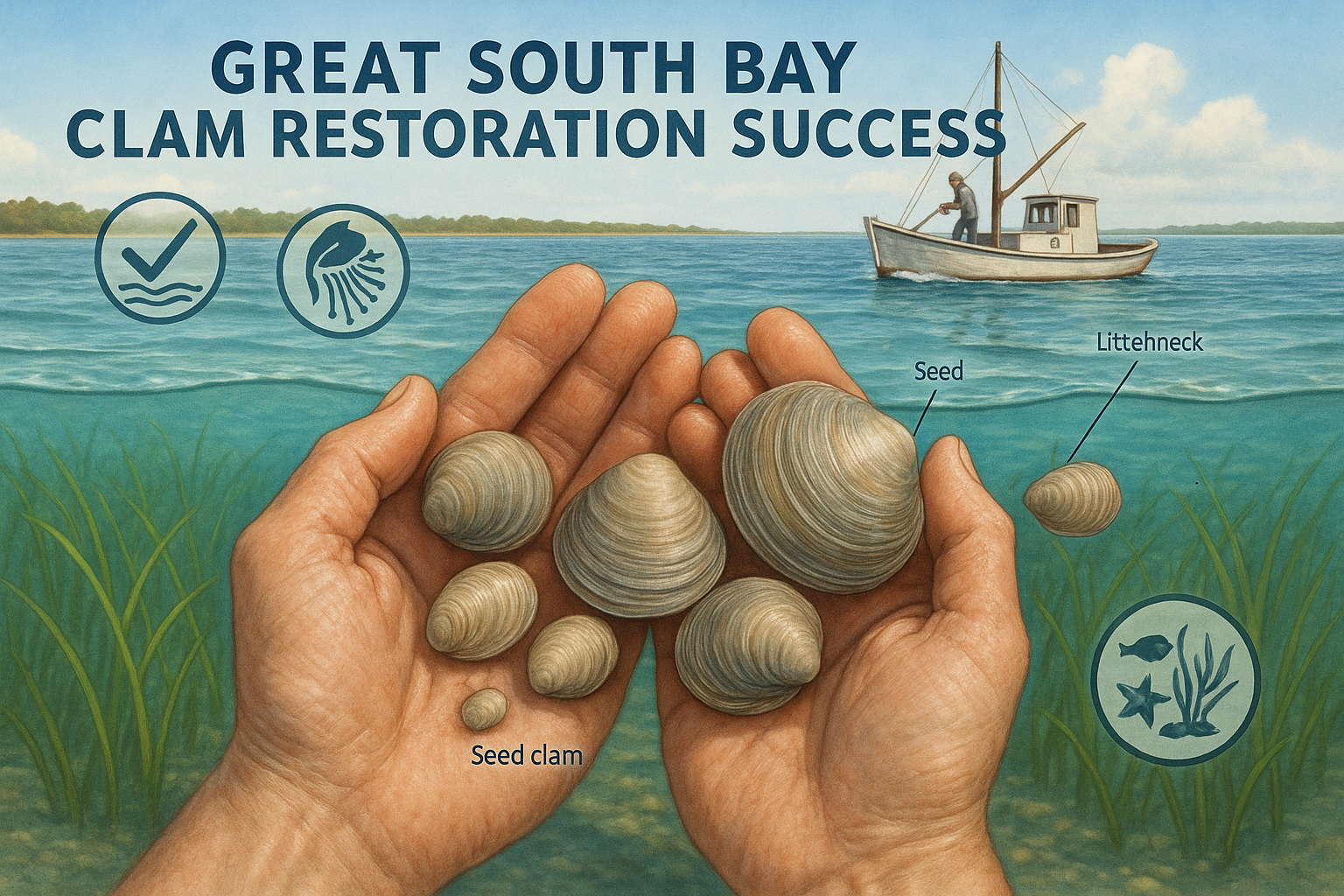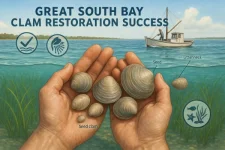- A Marine Biologist's Deep Dive

George, my friend, you've hit upon one of the most encouraging marine ecology stories of our time right here in our backyard waters. As someone who's seen these bays through decades of change – just like the folks sharing their experiences on nyangler – this clam resurgence represents a genuine biological triumph that deserves a deep scientific examination.
The Biological Foundation: Why Clams Matter
Mercenaria mercenaria – our beloved hard clam or "quahog" – isn't just another shellfish in the bay. From a marine biologist's perspective, these animals are what we call "ecosystem engineers." Think of them as the bay's natural water treatment plants, working 24/7 to maintain the delicate balance that supports all marine life.Here's what makes them so critical: A single adult hard clam can filter up to 50 gallons of water per day, removing algae, bacteria, and suspended particles. When we had healthy populations in the 1970s, the combined clam population in the Great South Bay filtered approximately 40% of the bay's entire water volume daily. That's biological horsepower that no human technology can match efficiently or affordably.
The Perfect Storm: What Caused the Collapse
The near-total collapse of clam populations in the Great South Bay wasn't due to a single factor but rather a cascading series of biological and environmental disasters:1. Recruitment Limitation - The Death Spiral
Hard clams are broadcast spawners – they release gametes into the water column where fertilization occurs. Success depends heavily on what marine biologists call "proximity fertilization efficiency." When adult populations drop below critical density thresholds (generally below 1-2 clams per square meter), the distance between spawning males and females becomes too great for successful fertilization.This creates what we call a "recruitment death spiral." Fewer adults mean fewer successful spawning events, which means fewer juveniles survive to become breeding adults. The population mathematically cannot sustain itself.
2. Nitrogen Loading and Eutrophication
Long Island has experienced a 60% increase in nitrogen concentrations in groundwater discharging into our bays since the 1970s. This excess nitrogen, primarily from septic systems and fertilizer runoff, triggers massive phytoplankton blooms. While you might think more phytoplankton would mean more food for filter-feeding clams, the reality is far more complex.The nitrogen loading shifted the phytoplankton community composition toward species that clams cannot effectively process or that are actually harmful to them. Most dramatically, it enabled the annual occurrence of "brown tides" – blooms of Aureococcus anophagefferens – that are directly toxic to hard clam larvae and juveniles.
3. Habitat Degradation
The bay lost 90% of its seagrass meadows, which serve as critical nursery habitat for juvenile clams. Seagrass beds provide protection from predation and create the specific microhabitat conditions (reduced wave action, modified sediment chemistry) that young clams need to establish and grow.Equally important was the loss of natural shell substrate. Historically, the massive oyster and clam populations created extensive shell beds that provided ideal settlement surfaces for new recruits and protective habitat that buffered against predation and harsh environmental conditions.
4. Predation Pressure
With clam populations at critically low levels, predation pressure on the remaining individuals became unsustainable. Blue crabs, whelks, and other natural predators that historically co-existed with abundant clam populations now encountered easy, concentrated targets. At low clam densities, predators can effectively eliminate recruitment before juveniles reach reproductive size.The Shinnecock Bay Success Story: A Biological Blueprint
While the Great South Bay was struggling, scientists at Stony Brook University were demonstrating how biological principles could drive restoration success in adjacent Shinnecock Bay. Their approach, published in the prestigious journal Frontiers in Marine Science, provides the scientific roadmap for what we're now seeing in the Great South Bay.The Spawner Sanctuary Strategy
The core innovation was establishing "spawner sanctuaries" – protected areas where adult clams were planted at high densities (25-45 clams per square meter). This wasn't just about adding more clams; it was about recreating the biological conditions necessary for successful reproduction.By concentrating adults in optimal locations, they:
- Maximized fertilization success through proximity
- Created larval production zones that could seed surrounding areas
- Established sustainable breeding populations protected from harvest
Hydrodynamic Modeling and Larval Dispersal
The scientists used sophisticated hydrodynamic models to predict how clam larvae would disperse from spawner sanctuaries. Hard clam larvae spend approximately two weeks in the plankton before settling, and the models showed that larvae from western sanctuaries would be carried throughout the bay by tidal currents – exactly what field sampling later confirmed using DNA-based tracking methods.Results That Speak to Biological Recovery
The Shinnecock Bay restoration produced remarkable results:- 1,700% increase in clam abundance and commercial landings
- Complete elimination of brown tide blooms (first six-year brown tide-free period since 1985)
- Recovery of over 110 acres of seagrass meadows
- Significant improvement in water clarity
The Great South Bay Renaissance: Biology Meets Anecdotal Evidence
Now, let's connect the science to what Crabman and other nyangler members are observing on the water. The reports of finding numerous seed clams alongside legal-sized adults represent exactly what marine biologists would expect from successful recruitment events.Size Class Distribution Analysis
When Crabman mentions finding "two seed clams for each little neck," he's describing what we call a healthy size-class distribution. This indicates:- Successful spawning events in recent years (the seed clams)
- Survival of those recruits to juvenile stages
- Ongoing reproductive potential (the adult breeding stock)
Spatial Distribution Patterns
The reports of clams returning to areas that were barren for decades align with biological recovery patterns. Once spawner populations reach critical mass, larval dispersal follows predictable hydrodynamic patterns, gradually recolonizing previously depleted areas.Growth Rate Observations
Crabman's observation that clams planted two years ago have reached top neck size demonstrates favorable environmental conditions. In clean water with adequate food sources, Mercenaria mercenaria exhibits rapid growth. The fact that growth rates have accelerated suggests improved water quality – likely due to reduced brown tide frequency and intensity.The Biological Mechanics of Bay Recovery
Filter Feeding and Ecosystem Services
As clam populations rebuild, they're reinstating critical ecosystem services:Water Filtration: Returning clam populations are processing millions of gallons of bay water daily, removing excess phytoplankton and clarifying the water column.
Nutrient Cycling: Clams transfer nutrients from the water column to the sediments through their feeding and excretion, helping to break the cycle of eutrophication.
Biodeposition: Clam feces and pseudofeces create organically rich sediments that support benthic communities and provide settling surfaces for future clam recruitment.
Positive Feedback Loops
Marine ecosystems can exhibit powerful positive feedback loops once recovery begins:- More clams → Better water quality → Better clam survival
- Improved water quality → Seagrass recovery → Better juvenile habitat
- Larger clam populations → More successful spawning → Higher recruitment
The "Tipping Point" Phenomenon
What nyangler members may be witnessing is an ecological tipping point – the moment when positive feedback loops overcome the negative pressures that maintained the degraded state. This isn't gradual change; it's often rapid and dramatic once critical thresholds are crossed.Current Restoration Efforts and Biological Interventions
Multiple Restoration Approaches
Current efforts in the Great South Bay employ several biologically-informed strategies:Hatchery Enhancement: Programs run by towns like Islip are growing clams to larger sizes (>25mm) before release, which dramatically improves post-release survival by moving juveniles past the highest predation mortality stage.
Substrate Enhancement: Restoration of shell beds and hard substrate provides settlement surfaces and predator refugia – addressing one of the key habitat limitations.
Water Quality Improvement: Ongoing efforts to reduce nitrogen loading attack the root cause of eutrophication and harmful algal blooms.
Spawner Sanctuary Expansion: Following the Shinnecock Bay model, protected breeding areas are being established to ensure sustainable recruitment.
Community-Based Restoration
Programs like the SPAT (Spawner Providing Aquaculture Training) initiative engage local communities in hands-on restoration. This approach recognizes that successful marine restoration requires both scientific understanding and community stewardship.The Biological Challenges That Remain
Brown Tide Persistence
While Shinnecock Bay has been brown tide-free since 2016, the Great South Bay still experiences periodic blooms. Recent reports indicate a significant brown tide outbreak in 2023, which could impact young clam survival. However, the fact that adult populations are now robust enough to provide continuous recruitment pressure suggests resilience that didn't exist during the population collapse.Climate Change Pressures
Rising temperatures, ocean acidification, and changing precipitation patterns all pose new challenges. However, healthy, genetically diverse populations are inherently more resilient to environmental change than stressed, depleted ones.Invasive Species
The recent appearance of invasive seaweeds like Dasysiphonia japonica creates new ecological pressures. These invasive species can alter oxygen levels and create novel predator-prey relationships that affect clam survival.Looking Forward: Biological Predictions and Management Implications
Population Dynamics Projections
Based on the biological understanding gained from Shinnecock Bay and early Great South Bay observations, we can make several predictions:- Continued Spatial Expansion: Clam populations should continue expanding into previously barren areas as larval supply increases and habitat conditions improve.
- Age Structure Normalization: We should see the development of more balanced age structures with strong year classes of juveniles supporting the fishery.
- Ecosystem Service Enhancement: As populations approach historical levels, we should see continued improvements in water quality, seagrass recovery, and overall ecosystem health.
Management Recommendations from a Biological Perspective
Adaptive Harvest Management: Harvest regulations should be adjusted based on real-time population assessments, protecting spawning stock during recovery while allowing sustainable utilization.Habitat Protection: Critical spawning and nursery areas should receive protection from physical disturbance, pollution, and development.
Integrated Restoration: Clam restoration should be coordinated with seagrass restoration, oyster restoration, and water quality improvement for maximum ecosystem benefit.
The Bigger Picture: Implications for Marine Conservation
The clam recovery story represents something much larger than a single species restoration success. It demonstrates that:- Science-based restoration works when biological principles are properly applied
- Marine ecosystems can recover rapidly once tipping points are crossed
- Community engagement and scientific expertise create powerful synergies
- Ecosystem services have real economic value that justifies conservation investment
Conclusion: A Biologist's Optimism
George, what you and the nyangler community are witnessing represents one of the most successful marine restoration stories of the modern era. The return of clams to the Great South Bay isn't just about shellfish – it's about the restoration of ecosystem function, the recovery of a maritime heritage, and proof that human actions can reverse environmental degradation.From a marine biologist's perspective, every bucket of clams that Crabman and his grandson harvest represents thousands of successful biological processes: successful spawning events, larval survival, juvenile growth, predator avoidance, and environmental resilience. Each clam is a small victory in the larger battle for healthy marine ecosystems.
The biological mechanisms driving this recovery are well understood, the restoration techniques are proven, and the community engagement is strong. While challenges remain – particularly climate change and ongoing pollution pressures – the fundamental biological infrastructure for a thriving clam population is being rebuilt.
As someone who's spent decades studying these systems, I can say with confidence: this is what successful marine conservation looks like. The Great South Bay clam recovery represents a biological triumph that should inspire similar efforts throughout the coastal United States and beyond.

